Get PeakVisor App
Sign In
Search by GPS coordinates
- Latitude
- ° ' ''
- Longitude
- ° ' ''
- Units of Length

Yes
Cancel
Share ×

Scan the QR code and open PeakVisor on your phone
❤ Wishlist ×
Choose
Delete
Encompassing more than 6 million acres (2.4 million hectares) of stunning forest and some of the highest peaks in the northeast, New York state’s Adirondack Park is one of the largest state parks in the United States. There are 1,601 named mountains in the park, the highest and most prominent of which is Mount Marcy at 5,335 ft (1,626 m).
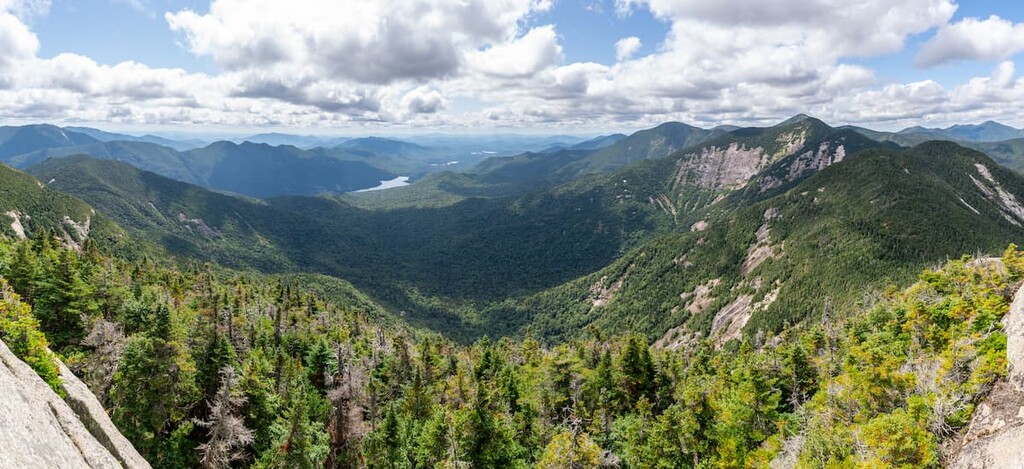
Adirondack Park covers almost one-fifth of the US state of New York, from just north of the Mohawk River at the southern end of the park to near the border with the provinces of Ontario and Quebec Canada in the north and Lake Champlain in the east.
The highest mountains in the Adirondacks are located in the High Peaks Wilderness in the northern end of the park. The High Peaks region contains 46 peaks with elevations around or above 4,000 ft (1,219 m), including 11 mountains with alpine summits that poke out above the treeline.
The High Peaks are incredibly popular with peak baggers. Hikers who summit all 46 peaks are known as 46ers. You can use the AHP46 list in the PeakVisor app to track your own peak bagging adventure in the Adirondacks, though you’ll need to register your climbs with the ADK46ers in order to claim your status as an official 46er.
In addition to rugged mountains, the park is home to more than 2,800 lakes, 30,000 miles (48,000 km) of rivers and streams, and an estimated 100,000 (40,000 ha) acres of old growth forests.
Adirondack Park is about the same size as the nearby state of Vermont and three times the size of Yellowstone National Park. Unlike most parks in the US, just over 50 percent of the Adirondack Park is managed as privately owned land. The 105 towns in Adirondack Park are home to 130,000 year-round residents, though the population swells during the summer months with seasonal residents.
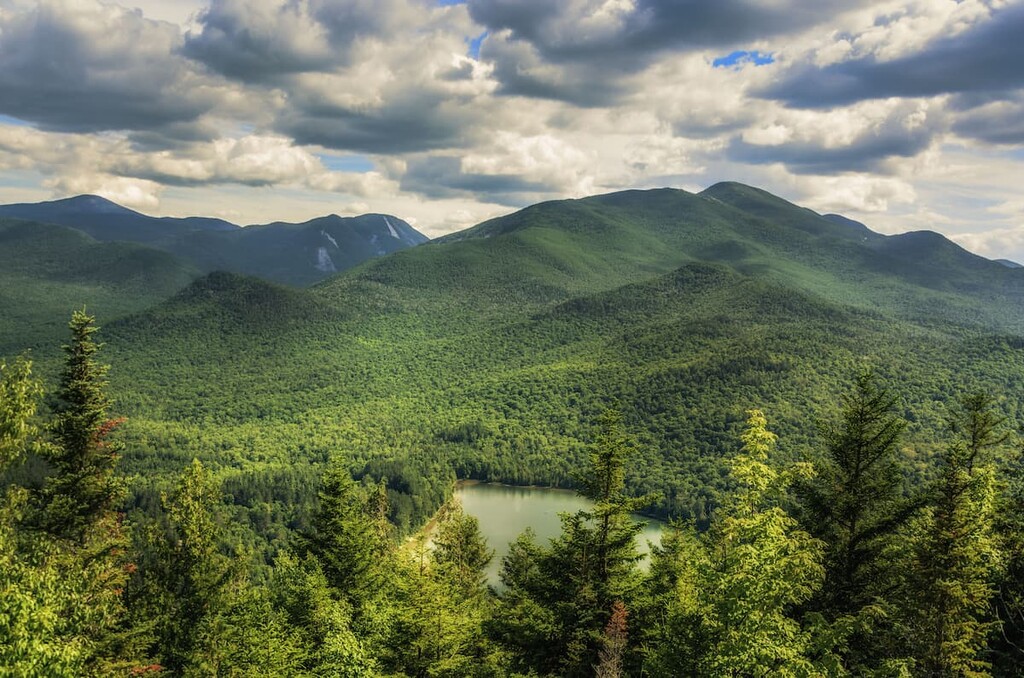
The other half of the Adirondack Park is state-owned forest preserve that is officially protected by the New York State Constitution (one of only two constitutionally protected landscapes in the world—the other is the Catskill Park, also located in New York).
About 1.3 million acres (525,000 ha) of the park’s public land is classified as wild forest, where motorized vehicles and greater recreation opportunities are allowed. Another one million acres (405,000 ha) is designated as wilderness, where motor vehicles are prohibited and the land is kept in its most natural state.
Despite the expansive wild lands in the region, the Adirondack Park hosts 200,000 seasonal residents and 12.4 million annual visitors. Unlike many US national parks, there’s no entry fee to the park, though you may have to pay for parking at certain trailheads.
The Adirondack Park is located in a mountainous part of the northeast with lots of hiking opportunities nearby. Catskill Park in New York, Green Mountain National Forest in Vermont and the Berkshires in Massachusetts are less than two hours away.
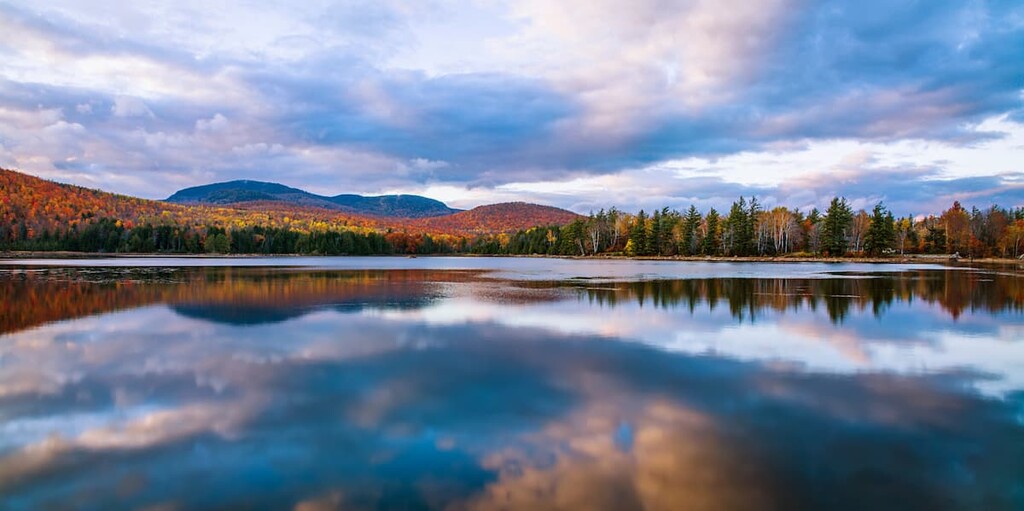
The Adirondacks are a unique, dome-shaped mountain range home to some of the most ancient rocks in the United States.
Instead of forming a long mountain chain like the Rockies or Appalachians, the Adirondacks are a circular cluster of peaks that form a dome some 160 miles (257 km) wide and 1 mile (1.6 km) high. Despite their proximity, the Adirondacks are distinct from the Appalachians and they have their own unique geologic history.
The northeastern Adirondacks are underlain by a large body of anorthosite, a relatively rare intrusive igneous rock with a high concentration of plagioclase feldspar. Additionally, the Adirondacks contain a large amount of highly metamorphosed rock, some of which is over a billion years old.
Much of the metamorphism that we see in the park’s rock strata is the result of the Grenville Orogenic Cycle, which caused widespread deformation of the local bedrock and, subsequently, the formation of the Adirondacks over the course of millions of years.
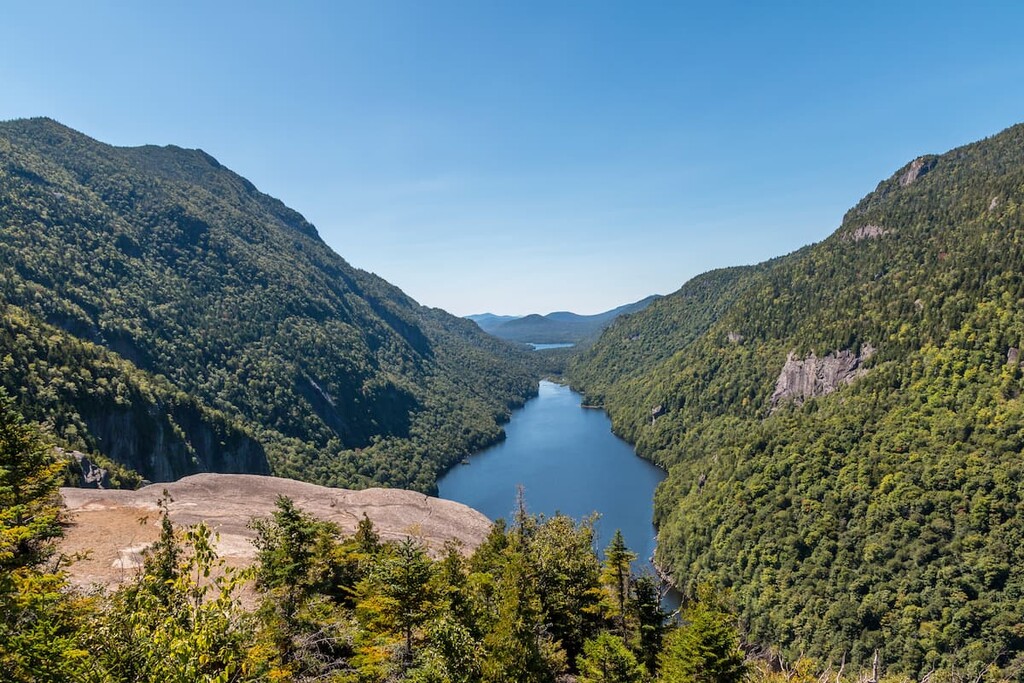
Furthermore, many of the landforms we see in the park today were carved out by the massive flowing glaciers that covered the landscape during the last glacial maximum, which produced the unique amphitheater-shaped cirques and kettle ponds the Adirondacks are known for. The mountains are still rising about 2 millimeters per year, faster than they’re being eroded.
The headwaters of five major drainage basins are located in the Adirondack Park, including those of the Black, Hudson, Saint Lawrence and Mohawk rivers. Many of the rivers that feed nearby Lake Champlain, including the Ausable and Saranac, also flow through the Adirondacks. Furthermore, about 15 percent of the park is covered by wetlands.
Indeed, the park’s rivers eventually supply water to communities as far away as New York City. Interestingly, the need to protect the headwaters of the Hudson (believed to be Lake Tear of the Clouds on the slopes of Mount Marcy), which supplies New York City’s water, was the impetus behind the original legislation that was designed to protect the Adirondacks.
The highest and most prominent point in Adirondack Park is Mount Marcy at 5,335 ft (1,629 m). Other notable peaks include Algonquin Peak, Haystack Mountain, Whiteface Mountain and Skylight Mountain.
The Adirondacks lie at the southern edge of the North American Boreal Forest, one of the largest boreal forests in the world. The park lies in a transition zone, so both coniferous trees such as pine, spruce, and larches are common, as are northern hardwood forests, which feature deciduous trees like beech and maple.
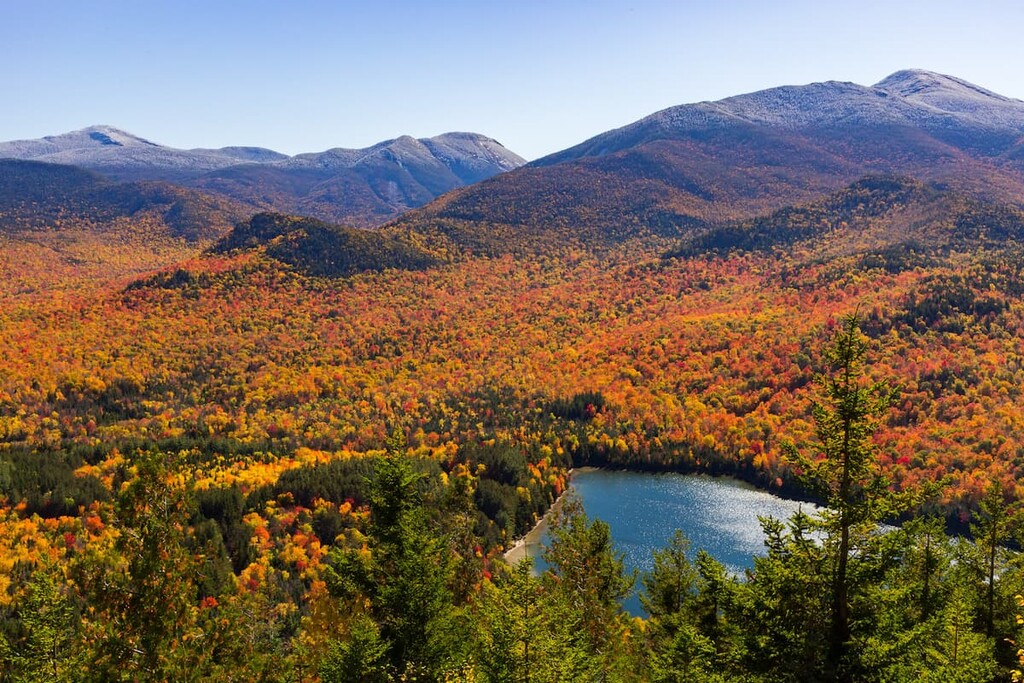
Most of the forests in the northeastern US were clear cut during the seventeenth and eighteenth centuries as a result of over logging. While many of the forests in the park have since regrown, this history of logging makes old growth forests rare in the region.
Nevertheless, the Adirondack Park is home to some 100,000 acres (40,000 ha) of old growth forests. This includes a 42,000 acre (17,000 ha) tract of pristine forest located in the Five Ponds Wilderness near Cranberry Lake that’s thought to be the largest unlogged area in the northeast.
During the fall, the Adirondacks are host to some of the most spectacular fall foliage in the world. Indeed, the mix of beeches, birches, and sugar maples, turn the landscape into a sea of bright reds, yellows, and oranges during the autumn months. Do keep in mind that fall is one of the busiest times of year for visitors to the park, so be wary of traffic issues on the park’s major roads.
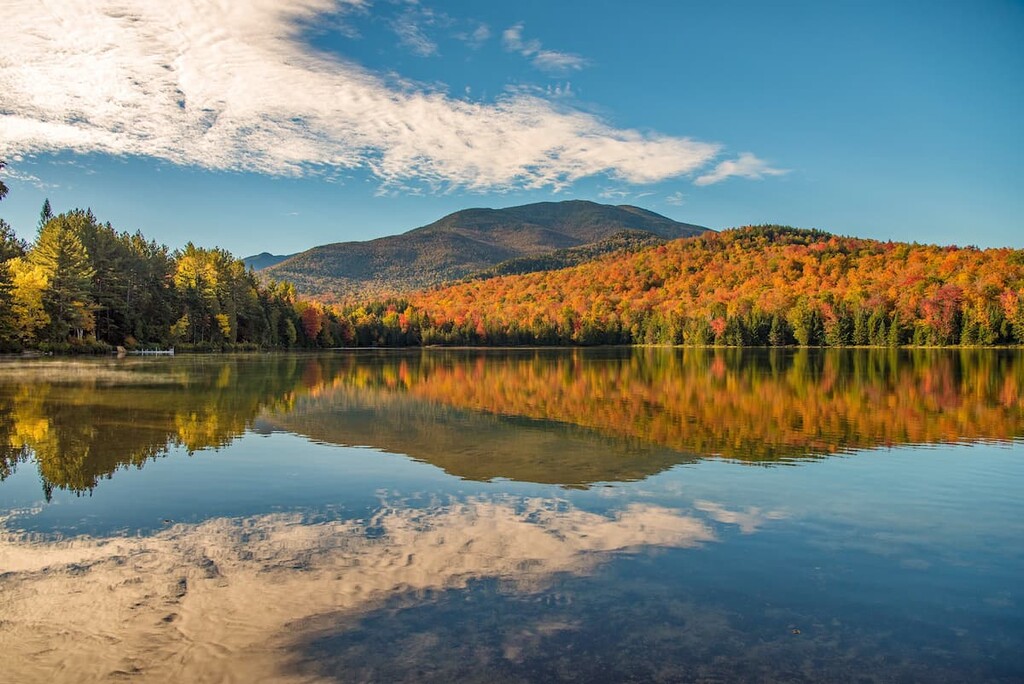
There are 53 species of mammals in Adirondack Park, along with 35 species of reptiles and amphibians, and dozens more species of birds, insects and fish. Some of the largest mammals in the park include moose, black bears and deer. River otters, bobcats, coyotes and coywolves are also found in the park, but are less commonly spotted.
The first humans in the Adirondacks were members of the Mohawk and Algonquin tribes. The word "Adirondack" supposedly means “barkeater” or "those who eat trees" in the Mohawk language, who used the term in a derogatory way to refer to the Aloginquin.
Both the Mohawk and Algonquin tribes were active in the area and used the land for hunting, fishing, and transit to other parts of the region. However, they were eventually pushed off their homelands by arriving settlers of European descent.
After the arrival of European colonists, the vast Adirondack lands were first claimed by the Dutch and then the British, and finally transferred to the state of New York after the Revolutionary War. In order to pay war debts, the state began selling the land to loggers and other developers.
Despite offering land at pennies an acre, development was slow at first. Indeed, the Adirondacks weren’t truly settled by peoples of European descent until the 1830s.
By the mid nineteenth century however, the area was experiencing a free-for-all of resource extraction. Frequently, large swaths of forest were clear cut and then returned to the state when taxes on the land went unpaid.
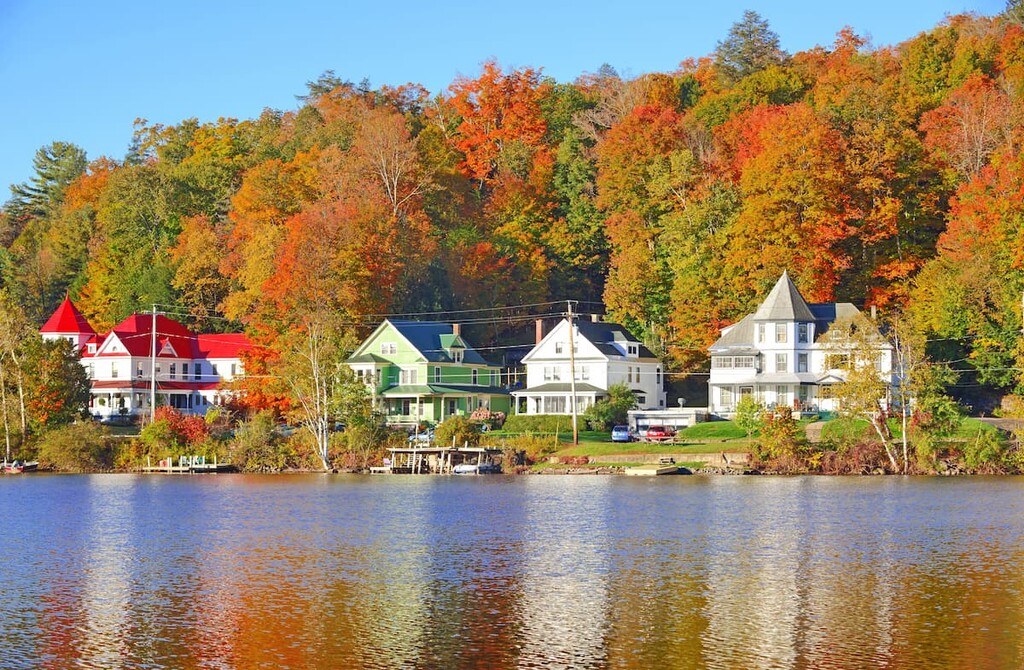
Soon enough, deforestation, overhunting of animals, and concerns about water supply in the industrial areas south of the Adirondacks (namely, New York City) led to calls for a forest preserve.
In 1894, the Adirondack Park was created by an article of the New York State Constitution. The protected wild lands can never be sold or leased without authorization from the state legislature and New York voters.
Only a few exceptions to the “forever wild” designation of the park have ever been granted, the most notable of which was the cutting of ski trails on Whiteface Mountain in 1940, and the construction of the main highway in the eastern part of the park, I-87, in 1958.
The Adirondack Park has hosted the Winter Olympic Games at Lake Placid twice, in 1932 and 1980. However, in more recent years, it has quickly established itself as a major outdoor recreation destination in the region. These days, the park is a popular year-round getway as it boasts fantastic climbing, hiking, paddling, and skiing opportunities for locals and visitors, alike.
The Adirondacks are a true hiker’s paradise. Here are some of the best hiking areas, trails, and opportunities within the park to check out during your next visit:
While the Adirondacks don’t boast a major long-distance trail, like the Appalachian Trail or Pacific Crest Trail, there are several challenging long distance treks within the park.
The Trans-Adirondack Trail extends 240 miles (386 km) from the northern edge to the southern edge of the park and it includes sections of both road walking and off-trail bushwacking. It was first completed in 2010 and inaugurated as a hiking route in 2013.
The Northville-Placid Trail runs 136 miles (219 km) through some of the most secluded parts of Adirondack Park. This is a relatively lightly trafficked trail with pristine wilderness and few resupply points.
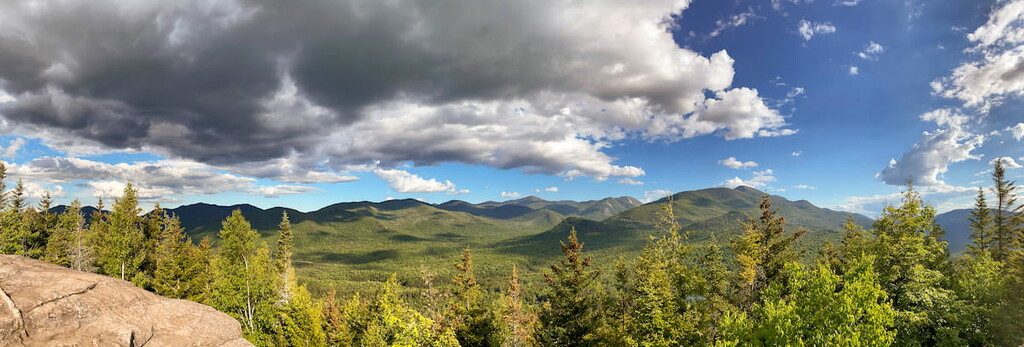
Another unique hiking opportunity in the Adirondacks are the 25 fire towers located in the park. The Adirondack Mountain Club’s Fire Tower Challenge, which requires hikers to climb to 18 fire towers in Adirondack Park and all five towers in nearby Catskill Park, is popular with hikers from all over the region.
By far the most popular and well-known hikes in Adirondack Park are located in the High Peaks Wilderness. This area is home to Mount Marcy, the highest peak in New York, along with Algonquin Peak, Whiteface Mountain, Haystack Mountain, and many of the other peaks in the Adirondacks with elevations over 4,000 ft (1,219 m).
There are numerous excellent trails in the High Peaks region, including trails for day hiking most of the tallest mountains, as well as longer backpacking trails. The Great Range Trail is one of the most classic (and brutal) hikes in the High Peaks, stretching over 12 peaks in 25 miles (40 km) and gaining 10,000 ft (3,048 m) of elevation. It crosses some of the most scenic areas of the park, including Gothics and Basin Mountain.
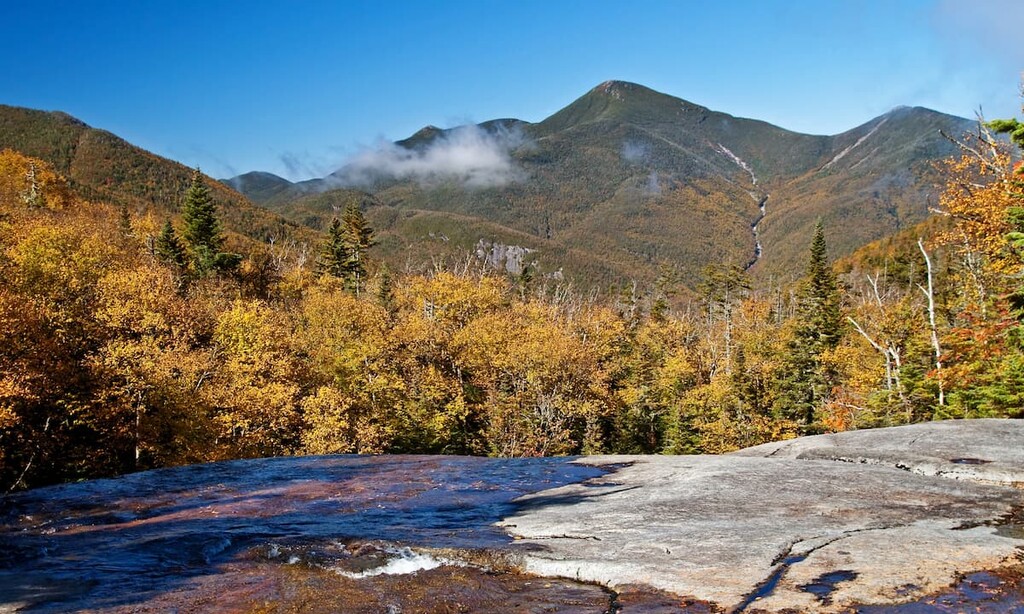
The northwestern Adirondacks are relatively quiet as they receive fewer tourists each year than the nearby High Peaks Wilderness.
This area includes Saranac, Tupper and Cranberry lakes. Some of the most popular hikes in the area are the Cranberry Lake Loop, a 50 mile (80 km) trail or the 15.1 mile (24.3 km) High Falls Loop. For those looking for a shorter day hike, the 3.6 mile (5.8 km), 744 ft (227 m) Bear Mountain Trail offers great views over Cranberry Lake.
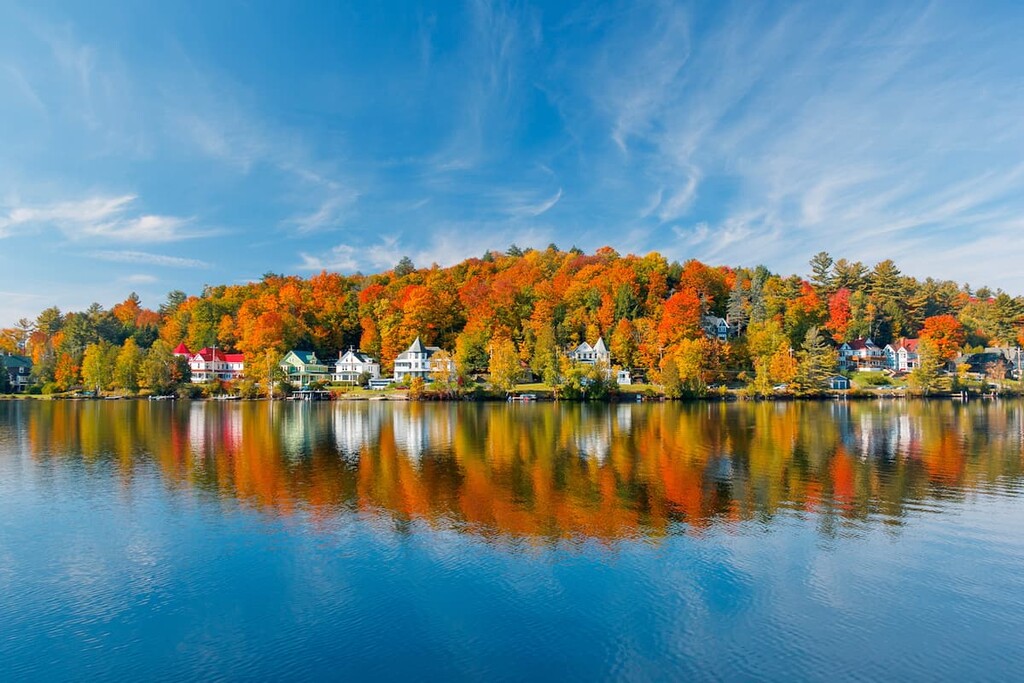
The Central Adirondacks are accessible via NY Route 30 and NY Route 28. Some of the most popular hiking areas are located in the Moose River Plains Wild Forest, Sargent Ponds Wild Forest, and the Hudson Gorge Wilderness.
These areas are home to some stunning waterfalls. One of the tallest waterfalls in the Adirondacks, the 200 ft (60 m) OK Slip Falls is accessible via a 3.2 mile (5.1 km) hike in the Hudson Gorge Wilderness. The Sargent Ponds Wild Forest is also home to Buttermilk Falls, one of the most visited waterfalls in the Adirondacks.
Meanwhile, the Moose River Plains Wild Forest is one of the largest blocks of undeveloped land in the Adirondacks that’s easily accessible by car. There are a number of trails in the region for hikers and equestrians to enjoy, including paths to Otter Brook, Mitchell Ponds, and Lost Ponds.
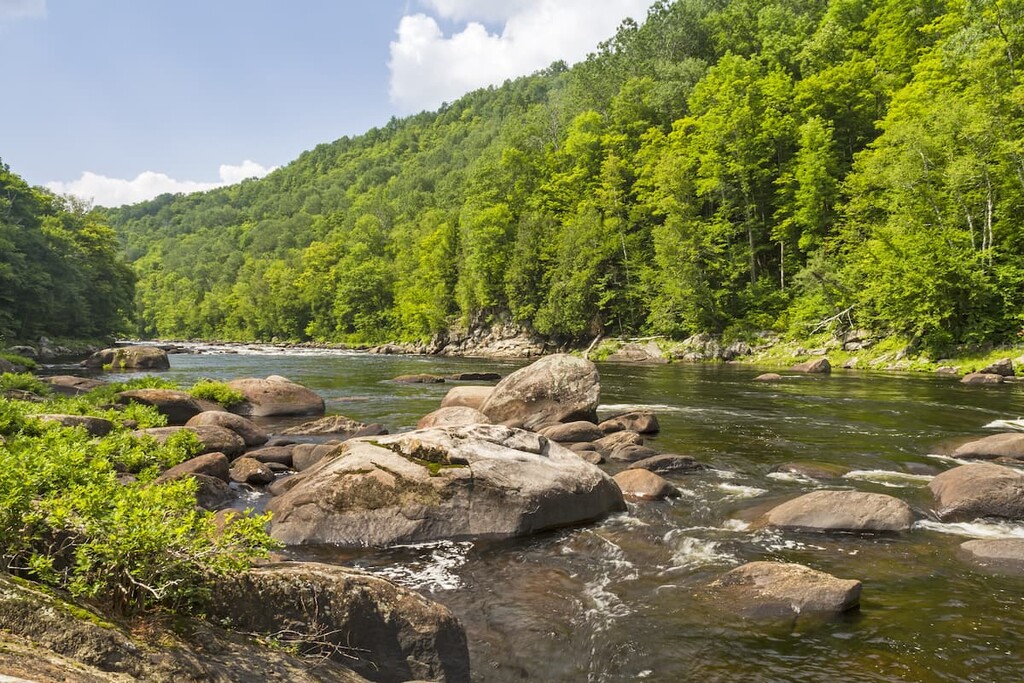
The Western Foothills of the Adirondacks include the Five Ponds Wilderness, Independence River Wild Forest, and the Black River Wild Forest.
For a short hike in the area with excellent views, head to Bald Mountain. The 2.0 mile (3.2 km) trail climbs 416 ft (127 m) to a fire tower for views over the lakes below. A new organization, known as the Fulton Chain Trifecta, also encourages hikers to complete nearby Rocky Mountain and Black Bear Mountain during their trip to Bald Mountain in order to encourage hikers to check out this stunning part of the Adirondacks.
Another easy hike with great payoff is the Cascade Falls Loop in the Pigeon Lake Wilderness, which gains just 300 ft (91 m) over 5.5 miles (8.6 km) and takes hikers past a 40 ft (12 m) waterfall.
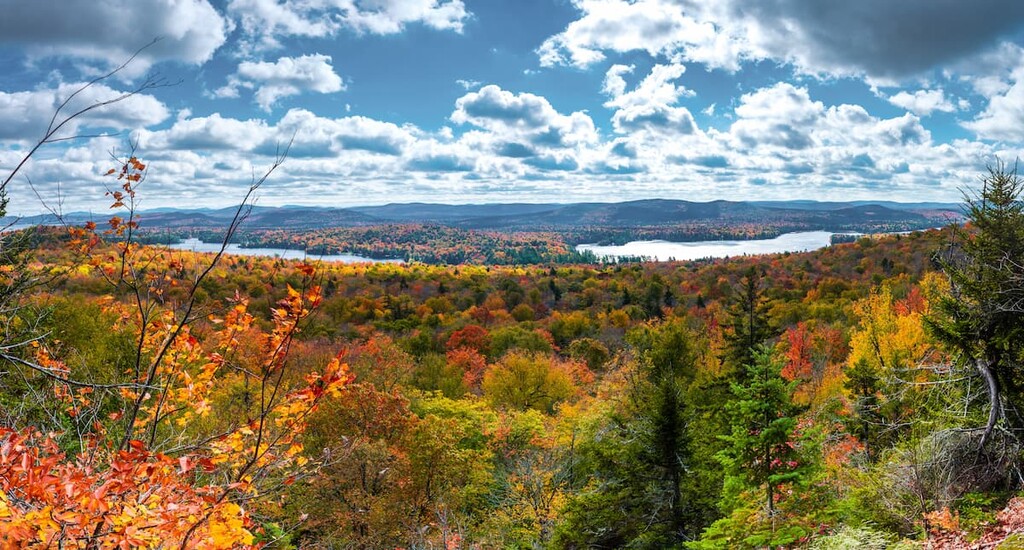
The Southern Woodlands contain some of the most famous and accessible spots in the Adirondacks, particularly around Lake George.
Prospect Mountain is one of the most popular hikes in the area, offering “100 mile views” of Lake George in a relatively strenuous 2.8 mile (4.5 km) hike that climbs 1,535 ft (468 m). Meanwhile, Black Mountain is another short, 2.5 mile (4 km) hike in the area that features ponds, a beach and a fire tower.
Alternatively, for a bit of a longer adventure, hikers can venture out and hike the so-called Tongue Range along the northern part of the lake. This trek allows you to summit French Point Mountain, Fifth Peak, and Fivemile Mountain, all while giving you great views of the region.
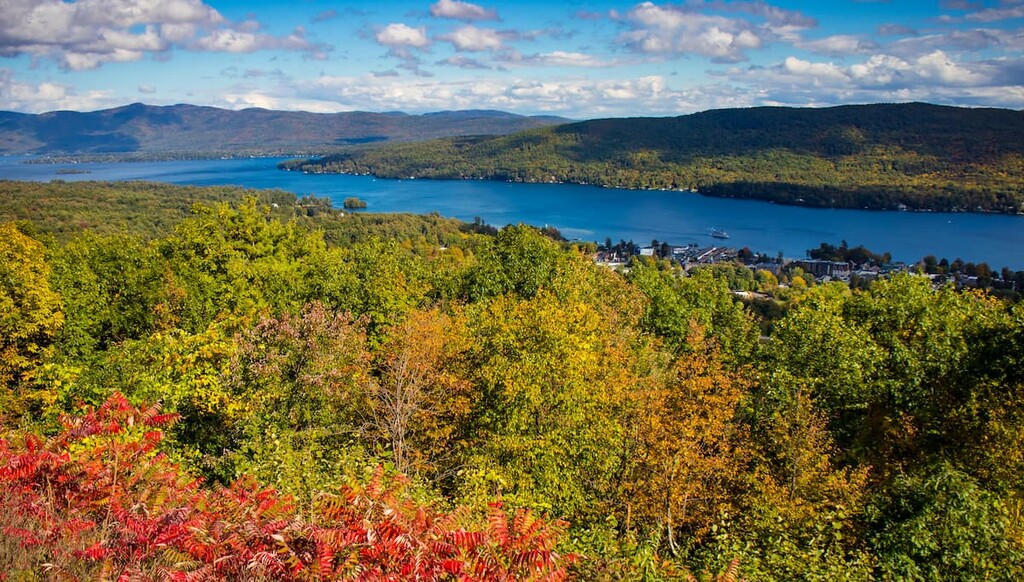
While it’s less visited than the nearby High Peaks Region, the Northeastern Adirondacks are home to some excellent hikes with a fraction of the high peaks crowds.
The 2.5 mile (4 km) trail to the summit of Jay Mountain in the Jay Mountain Wilderness offers 360 degree views and some of the best open ridgeline in the Adirondacks.
At lower elevations, the park hugs the shores of Lake Champlain. There are beautiful beaches and views to the Green Mountains in Vermont. Ausable Chasm, a stunning 2 mile (3.2 km) sandstone canyon with sheer vertical walls, is also located in the area.
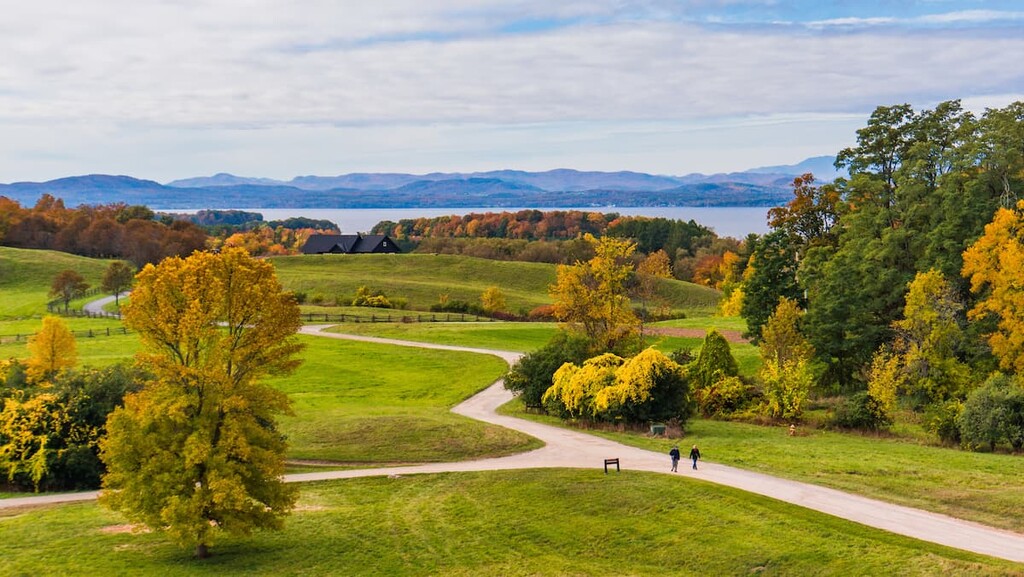
There are 105 towns and villages throughout Adirondack Park, each of which has its own unique charm and character. With so many different lodging options to choose from, the 12.4 million annual visitors to the park stay in everything from organized campgrounds and backcountry lean-tos to hotels and rustic cabins or luxurious Great Camps.
Many of the quaint towns along the I-87 corridor have great bed and breakfasts and inns. If you’re looking to stay in one of the larger towns, these are some of the most popular destinations:
One of the most picturesque and well-known towns in the Adirondacks is Lake George, which serves as a southern gateway to the region. The town and surrounding lake swells from about 3,000 to 50,000 residents in the summer.
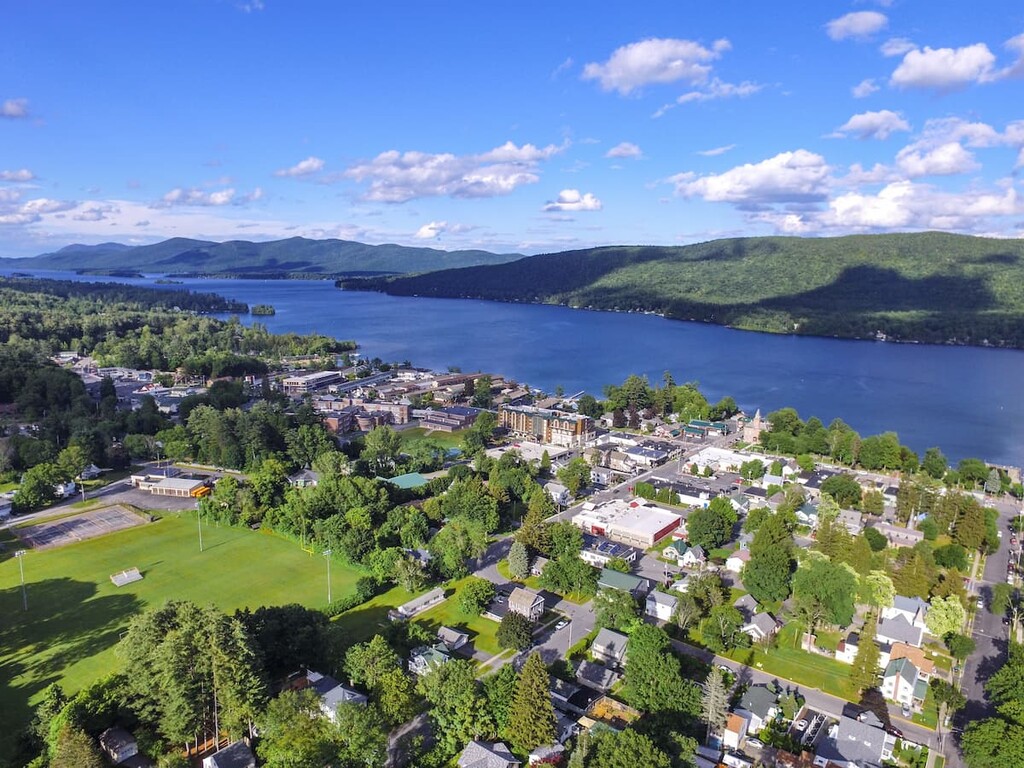
While much of the Adirondacks are known for their small-town vibes, Lake George is more of a summer resort-type destination. There are golf courses, an amusement park and a great selection of hotels and resorts.
Old Forge serves as one of the western gateways to Adirondack Park. It makes a great base for exploring the small towns and lakes of the western and central Adirondacks.
While Old Forge is only home to less than a thousand permanent residents, there are some great amenities for tourists, including Water Safari, the largest waterpark in New York. The nearby town Theandra is a stop on the Adirondack Scenic Railroad.
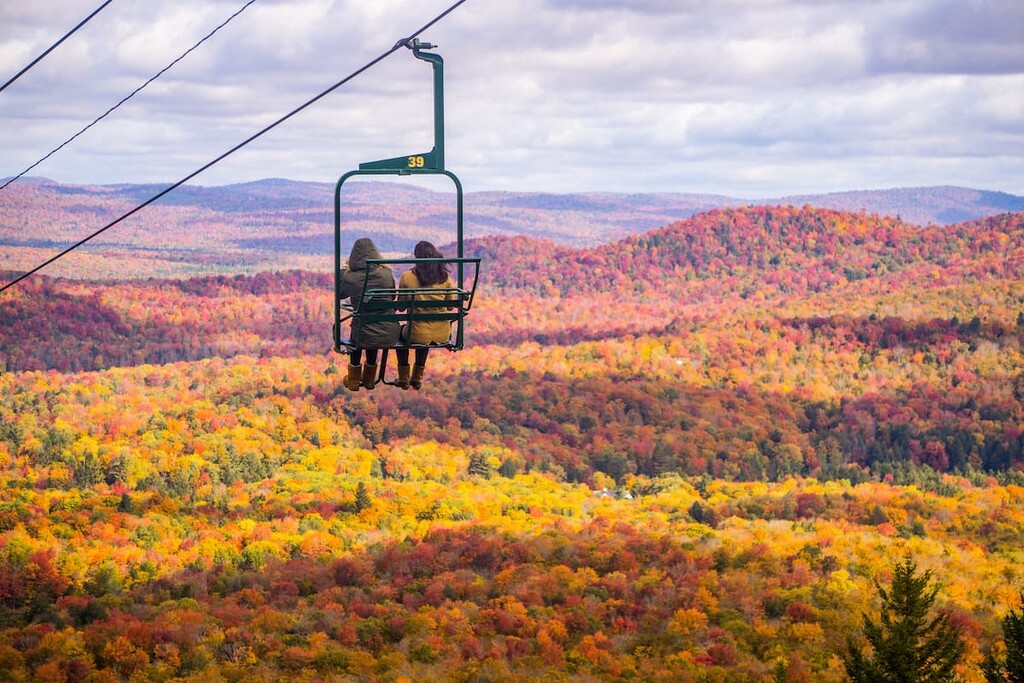
McCauley Mountain Ski Area offers cross country and downhill skiing, snowboarding and mountain biking. Visitors can also enjoy the TOBIE Trail, a 14-mile recreational pathway that connects Old Forge and the surrounding communities. The pathway is open to pedestrians, cyclists and other non-motorized users.
Located to the north of Lake George, Lake Placid is the other main tourist destination in the area. The town hosted the 1932 and 1980 Winter Olympics, and it still has the winter sports infrastructure from those events, including the ski jumps, speed skating rink, and bobsled run, all of which are still in use to this day.
There are extensive cross country skiing trails in the area, as well as downhill skiing on nearby Whiteface Mountain. In the spring, summer and fall, the town makes a convenient base for hikers looking to summit the Adirondack High Peaks.
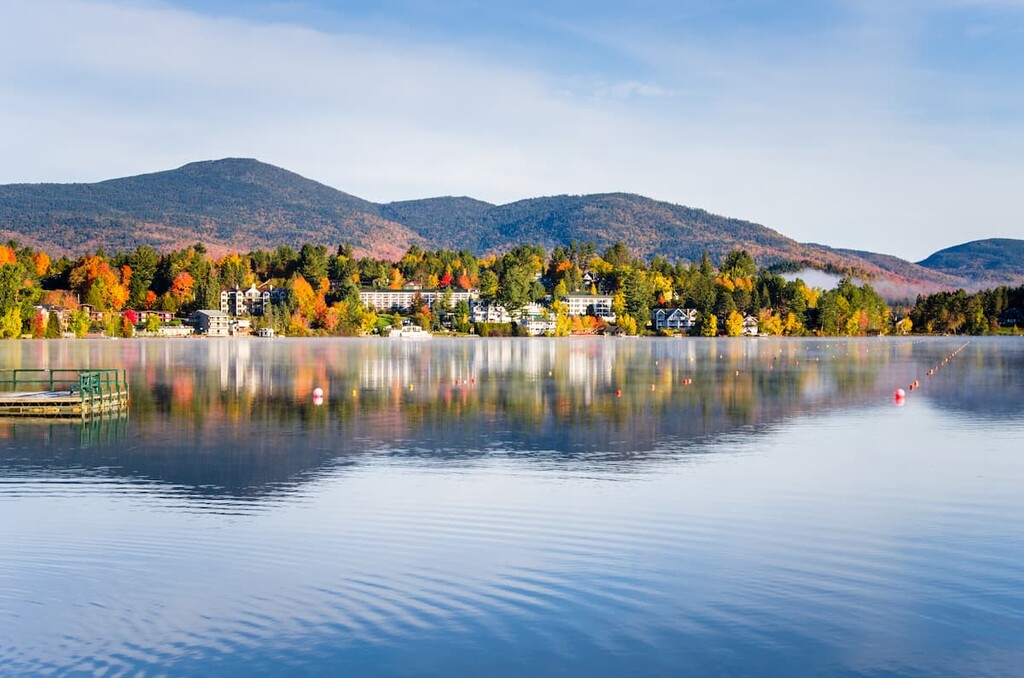
Keene Valley lies just below Mount Marcy and the other peaks of the Great Range, so it’s a popular base for serious hikers attempting to climb the High Peaks. The area includes the small towns of Keen and Keen Valley.
Many of the area’s best hiking trails leading over the High Peaks start from town. There’s also excellent rock and ice climbing on either side of Route 73. The Beer Walls offer some of the most easily accessible rock climbing in the Adirondacks.
The Keene Valley area is also home to several beautiful waterfalls. One hundred foot (30 m) Roaring Brook Falls and 20 foot (6 m) Bushnell Falls are both worth a visit.
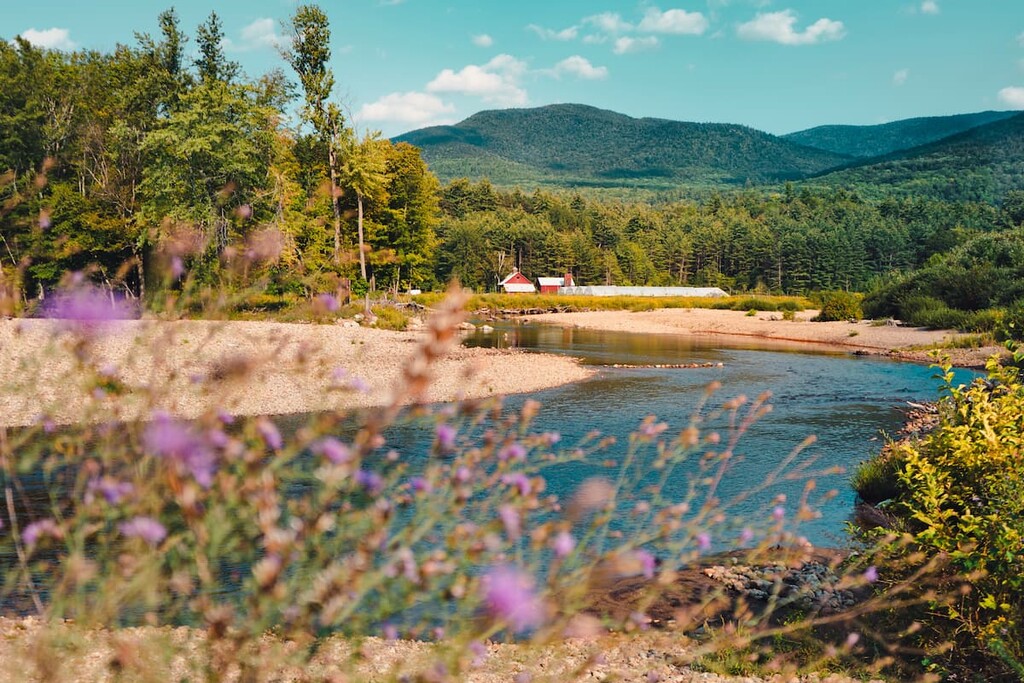
One of Tri-Lakes communities (along with Lake Placid and Tupper Lake), Saranac Lake is a quaint village of about 5,000 people. With its proximity to Flower Lake and Upper, Middle and Lower Saranac Lake, the town is a destination for canoers and kayakers. Saranac Lake also has a thriving downtown with galleries, shops and restaurants. The town offers numerous arts and culture events throughout the year.
During the summer months, Saranac Lake offers outdoor concerts and monthly art walks. In the winter, the town puts on a 10 day winter carnival, complete with an ice palace and full parade.
Saranac Lake is home to the Adirondacks only year-round, professional theater. There are over 200 properties in town that have been nominated to the National Register of Historic Places.
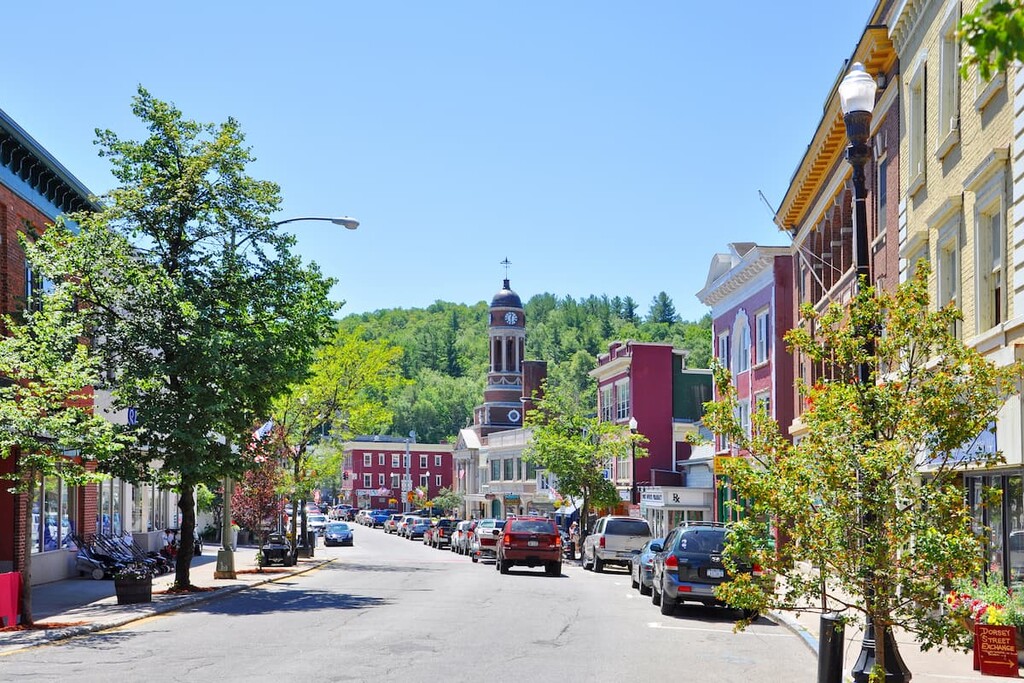
Explore Adirondack Park with the PeakVisor 3D Map and identify its summits.

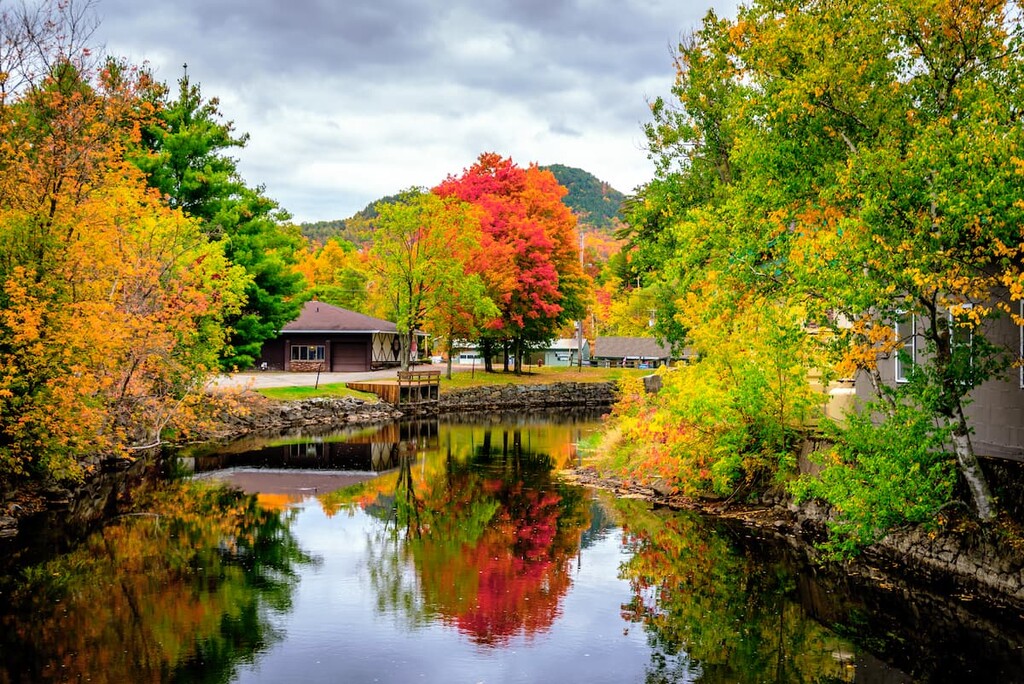






ahp46
northeast-115-4000ers
adirondack-top-100
fred-beckey-great-peaks
ahp46
northeast-115-4000ers
adirondack-top-100
fred-beckey-great-peaks
